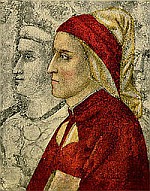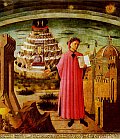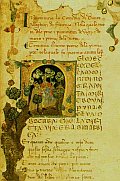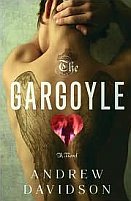Medieval Connections
Store
|
|
|

|

|
| Earliest portrait of
Dante Alighieri, by Giotto in Florence |

|
Dante holding copy
of Divine Comedy, painting by Michelino
|

|
| Manuscript of Dante's
Inferno, written in 1337
by Francesco di ser Nardo da Barberino, showing the beginning of
Dante's Comedy. |
|
Medieval
Book Reviews !
All
Things Medieval !
HOME MEDIEVAL
ROMANCE MEDIEVAL
MYSTERY MEDIEVAL
FICTION
MEDIEVAL ECHOES
AUTHORS
|
The Gargoyle

by Andrew Davidson
Dark,
mystical tale of medieval and modern redemptive love
An accident plunges an
unnamed narrator, a drug-addicted porn actor
into a physical and mental nightmare in a life that is already
spiraling downward. Horrifically burned, he loses the beautiful body of
which he had prided himself. His manhood, his human resemblance and his
very life are at stake as doctors and burn specialists try to help him
survive and recover when death itself appears the best result in his
own mind. Into the burn unit walks Marianne Engel, a carver of
gargoyles. She recognizes him as her lover, the mercenary whom her
medieval convent took in the first time he was burned. As he lies in
the burn unit, she tells him the story of her life as a medieval scribe
at Engelthal. Telling tales of spiritual and romantic love, of Meister
Eckhart, medieval German Christian life, Dante's INFERNO, medieval
Iceland and Japan, Marianne does for him what the doctors cannot do.
She reaches the space in him beneath the body. Is she insane as some
claim or is she a woman with a mystical vision from another time?
The initial pages of Andrew Davidson's THE GARGOYLE shock with
gut-wrenching meticulous and grotesque images of burns and burn
medicine. The reader recoils from such an image of horror, even in its
scientific presentation, as one might looking at the physical image of
the burned narrator. As a drug addict and porn actor, the darker side
of society and humanity, the temptation is to put away the book in a
safe corner and avert the eyes. When Marianne Engel enters, the reader
is as unsure of her as the narrator and the doctors. Is she crazy and,
if so, how? As she begins to tell her stories, the reader is drawn into
another world far removed from modern times, a world that understands
love and life with a medieval and spiritual vision. Marianne's quest to
suffer and become close to Christ places her right in tune with the
Medieval mystics. Not at all in tune with the modern reality, her
stories get at a different kind of truth, one that is literary and
spiritual --- just what the narrator needs. Indeed, to readers familiar
with the Medieval world, her stories take the reader to mystical
heights that move the heart as Dante's INFERNO becomes internalized
within the narrator's struggles. Although today's standards would view
her ideas as a psychological disorder, this Medieval world view and the
love between them reaches the narrator in ways modern medicine cannot.
The power of the story as story and the redemptive power of her love
gives the narrator a different means with which to view his own story.
As the reader enters into the imaginative space of THE GARGOYLE, the
reader him/herself experiences a similar suspension of modern
sensibilities and an opening into a different kind of reality. Andrew
Davidson's inspired descriptions of the narrator's body and Marianne's
sculptures converge. Through his narrative, the reader turns from
revulsion at the narrator's body to the heart within.
As the novel progresses, Marianne races against time to bring the
hearts of her gargoyle sculptures to life as the narrator comes face to
face with his addiction to the morphine given to him during his burn
recovery. The tone of the novel and their life becomes more frantic as
modern life crashes in on their world. As Marianne turns her attention
to her sculptures, the reader catches a glimpse of artistic madness.
After reaching such mystical off-the-scale heights in the earlier parts
of the novel, the ending, while very good in and of itself, feels like
a slight let down or slightly expected compared to the unusual, truly
stunning aspects of the rest of the novel. Also, women readers and
feminists might feel a tiny bit of disappointment in the ending which
in its closure turns a novel of poetic beauty towards both the narrator
and Marianne's story into a story that feels more traditionally and
slightly more exclusively the hero's journey. For most of the novel,
his stunning portrait of Marianne reaches such an exquisite level of
detail, unlike some Medieval texts' depiction of women, that this
reader expected something a bit more unusual. That being said, the
ending is still very good, but just not quite at the level of the rest
of the novel.
Andrew Davidson's THE GARGOYLE is an absolute must read for any
medieval junkie. The author's sense of the medieval literature and
Christianity makes this medievalist feel right at home. The unusual
modern setting and characters bring a freshness to a classic vision,
renewing medieval sensibilities with an eclectic powerful vision of
literature internalized in his heart and externalized in his body. Like
Dante's Beatrice, Marianne brings the reader to a space of redemptive
love but THE GARGOYLE is also more than just a slavish modernization of
Dante's literary and spiritual vision. Andrew Davidson intertwines
several strands of medieval literary and Christian mysticism in an
unconventional manner. Although the beginning was excruciatingly
painful in terms of the detail, and the narrator's past makes him a
reject from polite circles of society, these details are exactly the
darkness from which the level of redemption becomes so moving. If you
are looking for a light easy read, this is not the book for you. If you
have a deep love and knowledge of the medieval literature and Christian
mysticism, and also enjoy the dark and the eclectic in your modern
reads, Andrew Davidson's THE GARGOYLE is stunning, a book to reread and
cherish.
|
Book Description:
An
extraordinary debut novel of love that survives the fires of hell and
transcends the boundaries of time.
The
narrator of The Gargoyle
is a very contemporary cynic, physically beautiful and sexually adept,
who dwells in the moral vacuum that is modern life. As the book opens,
he is driving along a dark road when he is distracted by what seems to
be a flight of arrows. He crashes into a ravine and suffers horrible
burns over much of his body. As he recovers in a burn ward, undergoing
the tortures of the damned, he awaits the day when he can leave the
hospital and commit carefully planned suicide—for he is now a monster
in appearance as well as in soul.
A
beautiful and
compelling, but clearly unhinged, sculptress of gargoyles by the name
of Marianne Engel appears at the foot of his bed and insists that they
were once lovers in medieval Germany. In her telling, he was a badly
injured mercenary and she was a nun and scribe in the famed monastery
of Engelthal who nursed him back to health. As she spins their tale in
Scheherazade fashion and relates equally mesmerizing stories of
deathless love in Japan, Iceland, Italy, and England, he finds himself
drawn back to life—and, finally, in love. He is released into
Marianne's care and takes up residence in her huge stone house. But all
is not well. For one thing, the pull of his past sins becomes ever more
powerful as the morphine he is prescribed becomes ever more addictive.
For another, Marianne receives word from God that she has only
twenty-seven sculptures left to complete—and her time on earth will be
finished.
|
|

|
|